
Missing Pieces: 6 Aspects of the Poston Incarceration Camp
In the turbulent aftermath of Pearl Harbor in 1941, more than 125,000 Japanese American citizens on the West Coast were forced from their homes and imprisoned in remote incarceration camps. Families were uprooted abruptly. Lives were upended without charges, without due process, without justice.
My grandmother, Mari Matsumoto, was one of them. She was a young adult when she and her family were stripped of their California home and sent to the Colorado River “Relocation Center” in Poston, Arizona. I never learned this history in school, and my grandmother - like many Nisei - carried the weight of those memories quietly, speaking of them only rarely, and only much later in life.
Eighty years after her incarceration, I traveled to Poston with thirty-five Matsumoto relatives for the annual pilgrimage. I photographed moments of reunion, remembrance, and quiet recognition. But the six images that follow linger with me most. They seem to hold the emotional residue of my grandmother’s story - the ache of what was taken, the resilience of what endured, and the shadow this injustice still casts across generations.
These photographs were made in the newly reopened auditorium of Camp 1’s elementary school, shortly after its ribbon-cutting ceremony, using a Fujifilm X100F. My deepest gratitude goes to the Poston Community Alliance and the Colorado River Indian Tribes, whose stewardship and generosity allow descendants like us to return, remember, and bear witness.





